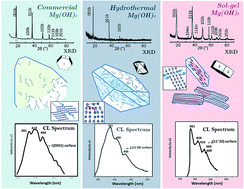Correlation between microstructure and cathodoluminescence properties of Mg(OH)2 (brucite) nanoparticles: effect of synthesis method
Abstract
This study presents a correlation between microstructure, atomic-scale observations and intrinsic cathodoluminescence (CL) emission from two types of brucite (Mg(OH)2) nanoparticles synthesized by hydrothermal and sol–gel methods, and a third one that was commercially acquired. It is reported, for the first time, spectral CL in an environmental scanning electron microscope, in the blue region (λ ∼300–660 nm). X-ray diffraction (XRD), environmental and field emission scanning electron microscopy (ESEM, FESEM) transmission electron microscopy (TEM) and high-resolution transmission electron microscopy (HRTEM)-electron diffraction were carried out for morpho-structural characterization. HRTEM observations allowed highlighting features at the atomic scale, including the different degrees of misfit inherent to each type of synthesis. Dislocations and stacking faults were oriented parallel to 0001 planes, giving rise to strain fields that explained the strongly preferred orientation observed by XRD in the commercial sample. In the same way, edge dislocations affected the 0001 planes of the hydrothermal sample. In the sol–gel sample, distortions produced by bent lattice planes affected the stacking sequence of 011–1 planes and confirmed the XRD results. CL showed strong dependence on particle orientation. Stable signals with peaks at 381 nm (3.25 eV), 409 nm (3.03 eV) and 466 nm (2.66 eV) were detected in the three samples along the (11–20) surface after applying 20 kV. Some differences in the intensity degree and peak position were detected in the (0001) surface. Additional signals at 425 (2.91 eV) and 488 (2.54 eV) detected in the sol–gel sample confirmed the presence of magnesite (MgCO3) due to carbonation processes. The intrinsic CL emissions were associated with differences in the development of lattice strains, which produced luminescence centers. Better understanding of intrinsic CL was achieved thanks to the correlation with microstructure and atomic-scale properties.



 Please wait while we load your content...
Please wait while we load your content...